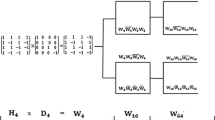Abstract
This paper analyzes new binary spreading codes through correlation properties and also presents their performance over additive white Gaussian noise (AWGN) channel. The proposed codes are constructed using gray and inverse gray codes. In this paper, a n-bit gray code appended by its n-bit inverse gray code to construct the 2n-length binary user codes are discussed. Like Walsh codes, these binary user codes are available in sizes of power of two and additionally code sets of length 6 and their even multiples are also available. The simple construction technique and generation of code sets of different sizes are the salient features of the proposed codes. Walsh codes and gold codes are considered for comparison in this paper as these are popularly used for synchronous and asynchronous multi user communications respectively. In the current work the auto and cross correlation properties of the proposed codes are compared with those of Walsh codes and gold codes. Performance of the proposed binary user codes for both synchronous and asynchronous direct sequence CDMA communication over AWGN channel is also discussed in this paper. The proposed binary user codes are found to be suitable for both synchronous and asynchronous DS-CDMA communication.








Similar content being viewed by others
References
J.L. Walsh, A closed set of normal orthogonal functions. Am. J. Math. 45 (1923)
Website for CDMA2000, WCDMA standards: http://www.3gpp.org
E. Dinan, B. Jabbari, Spreading codes for direct sequence CDMA and wideband CDMA cellular networks. IEEE Commun. Mag. 48 (1998)
K. Fazel, S. Kaiser, Multi carrier and spread spectrum systems (Wiley, New York, 2003)
D. Torreri, Principles of Spread Spectrum Communication Systems (Springer, Berlin, 2005)
M.A. Abu-Rgheff, Introduction to CDMA Wireless Communications (Elsevier, Amsterdam, 2005)
A. Mitra, On Pseudo random and orthogonal binary spreading sequences. World Acad. Sci. Eng. Technol. 48, 676 (2008)
A.N. Akansu, R. Poluri, Walsh-Like nonlinear phase orthogonal codes for direct sequence CDMA Communications. IEEE Trans. Signal Process. 55(7), 3800 (2007)
R. Poluri, A.N. Akansu, Short Length CDMA Codes for Wireless Sensor Networks. IEEE Sarnoff Conference, 2007
S. Spinsante, S. Andrenacci, E. Gambi, Binary De Bruijn sequences for DS-CDMA systems: analysis and results. EURASIP J. Wirel. Commun. Netw. (2011)
K. Usha, K. Jaya Sankar, Binary orthogonal code generation for multi-user communication using gray and inverse gray codes. Int. J. Electron. Commun. Eng. 5(2), 165 (2012)
F. Gray, Pulse Code Communication. U.S. Patent No. 2632058 (1953)
K.J. Sankar, V.M. Pandharipande, P.S. Moharir, Generalized gray codes. Intel. Signal Process. Commun. Syst. 654 (2004)
D.-M. Pham, A.B. Premkumar, A.S. Madhukumar, Error detection and correction in communication channels using inverse gray RSNS codes. IEEE Trans. Commun. 59(4), 975 (2011)
K. Usha, K. Jaya Sankar, A technique for the construction of inverse gray codes. Indian J. Emerg. Trends Eng. Dev. 2(2), 337 (2012)
D.V. Sarwate, M.B. Pursley, Correlation properties of pseudo random and related sequences. Proc. IEEE 68(5), 593 (1980)
T. Lang, X.H. Chen, Comparison of correlation parameters of binary codes for DS/CDMA systems. Proc. ICCS 1059 (1994)
V. Anil Kumar, A. Mitra, S.R.M. Prasanna, On the effectively of different pseudo-noise and orthogonal sequences for speech encryption from correlation properties. World Acad. Sci. Eng. Technol. 48 (2008)
V. Dasilva, E.S. Sousa, Performance of Orthogonal CDMA Codes for Quasi-Synchronous Communication Systems. ICUPC 995 (1993)
G.N. Karystinos, D.A. Pados, New bounds on the total squared correlation and optimum design of DS-CDMA binary signature sets. IEEE Trans. Commun. 51, 48 (2003)
H. Ganapathy, D.A. Pados, G.N. Karystinos, New bounds and optimal binary signature sets—Part I: periodic total squared correlation. IEEE Trans. Commun. 59, 1123 (2011)
H. Ganapathy, D.A. Pados, G.N. Karystinos, New bounds and optimal binary signature sets—Part II: aperiodic total squared correlation. IEEE Trans. Commun. 59, 1411 (2011)
Author information
Authors and Affiliations
Corresponding author
Rights and permissions
About this article
Cite this article
Usha, K., Jaya Sankar, K. Performance Analysis of New Binary User Codes for DS-CDMA Communication. J. Inst. Eng. India Ser. B 97, 61–67 (2016). https://doi.org/10.1007/s40031-014-0163-3
Received:
Accepted:
Published:
Issue Date:
DOI: https://doi.org/10.1007/s40031-014-0163-3




